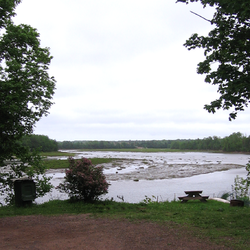River John: Difference between revisions
No edit summary |
|||
| Line 19: | Line 19: | ||
Communities situated on the lower reaches of the river include River John, Marshville and Welsford (formerly River John Village).<ref>[http://www.parl.ns.ca/placenames/pictouw.htmlWelsford, Name Places of Pictou County]</ref> The upper reaches in the [[Cobequid Hills]] began to be settled in the early nineteenth century at West Branch River John, Diamond, Loganville, and Dalhousie Settlement. |
Communities situated on the lower reaches of the river include River John, Marshville and Welsford (formerly River John Village).<ref>[http://www.parl.ns.ca/placenames/pictouw.htmlWelsford, Name Places of Pictou County]</ref> The upper reaches in the [[Cobequid Hills]] began to be settled in the early nineteenth century at West Branch River John, Diamond, Loganville, and Dalhousie Settlement. |
||
The River John is tidal for part of its length. |
The River John is tidal for part of its length. |
||
==Agriculture and Fishing== |
|||
In river john the farming and fishing are a main means for survival and economic growth. |
In river john the farming and fishing are a main means for survival and economic growth. |
||
Revision as of 14:40, 29 March 2012
| River John | |
|---|---|
 | |
 | |
| Physical characteristics | |
| Mouth | Northumberland Strait |
• elevation | sea level |
- This article is about the river. See River John, Nova Scotia for the article about the village.
River John is a river in Nova Scotia. Draining the extreme western part of Pictou County, it flows into Amet Sound on the Northumberland Strait at River John, a village which takes its name from the river. The Mi’kmaq name is Kajeboogwek (“flowing through desert or solitary place”). An early name was Deception River. Its present name is believed to derive from Rivière Jaune, an Acadian name,[1] though it may also derive from nearby Cap Jean (now Cape John).[2] DesBarres called it River John in his Atlantic Neptune. why deception we did nothing
Permanent settlement began in the late eighteenth century. In the nineteenth century, the river was an important scene of wooden ship building. In 1884, the largest ship ever built in Pictou County, the 1,687-ton Warrior was launched by the Kitchin yard, while rival Archibald MacKenzie launched the 1,574-ton Caldera that same year.[3]
Communities situated on the lower reaches of the river include River John, Marshville and Welsford (formerly River John Village).[4] The upper reaches in the Cobequid Hills began to be settled in the early nineteenth century at West Branch River John, Diamond, Loganville, and Dalhousie Settlement. The River John is tidal for part of its length.
Agriculture and Fishing
In river john the farming and fishing are a main means for survival and economic growth.
External links
References
- ^ Place Names of Nova Scotia
- ^ Sunrise Trail
- ^ Charles A. Armour and Thomas Lackey, Sailing Ships of the Maritimes, 1975, Toronto: McGraw Hill Ryerson, p. 162
- ^ Name Places of Pictou County
lies
